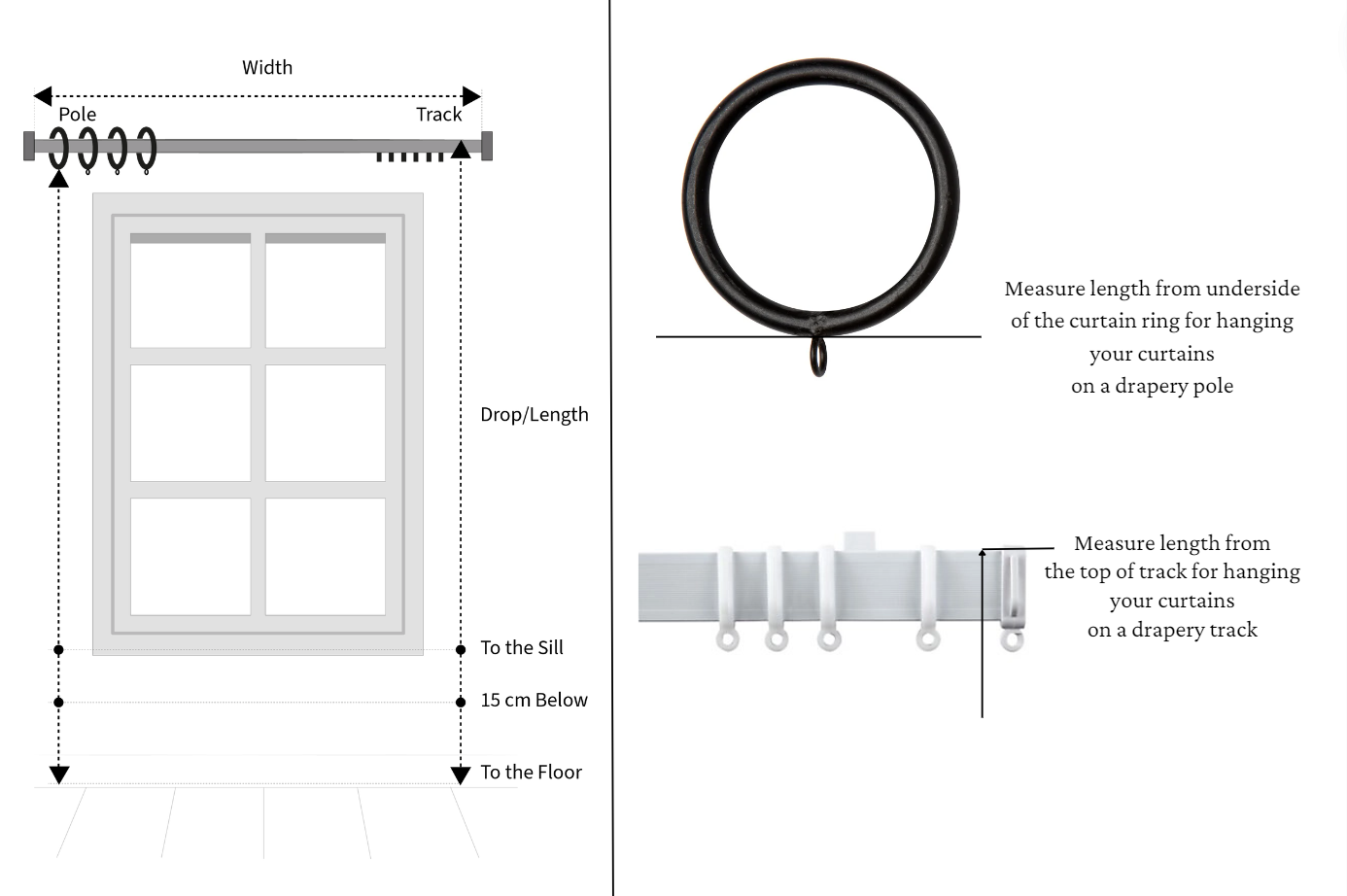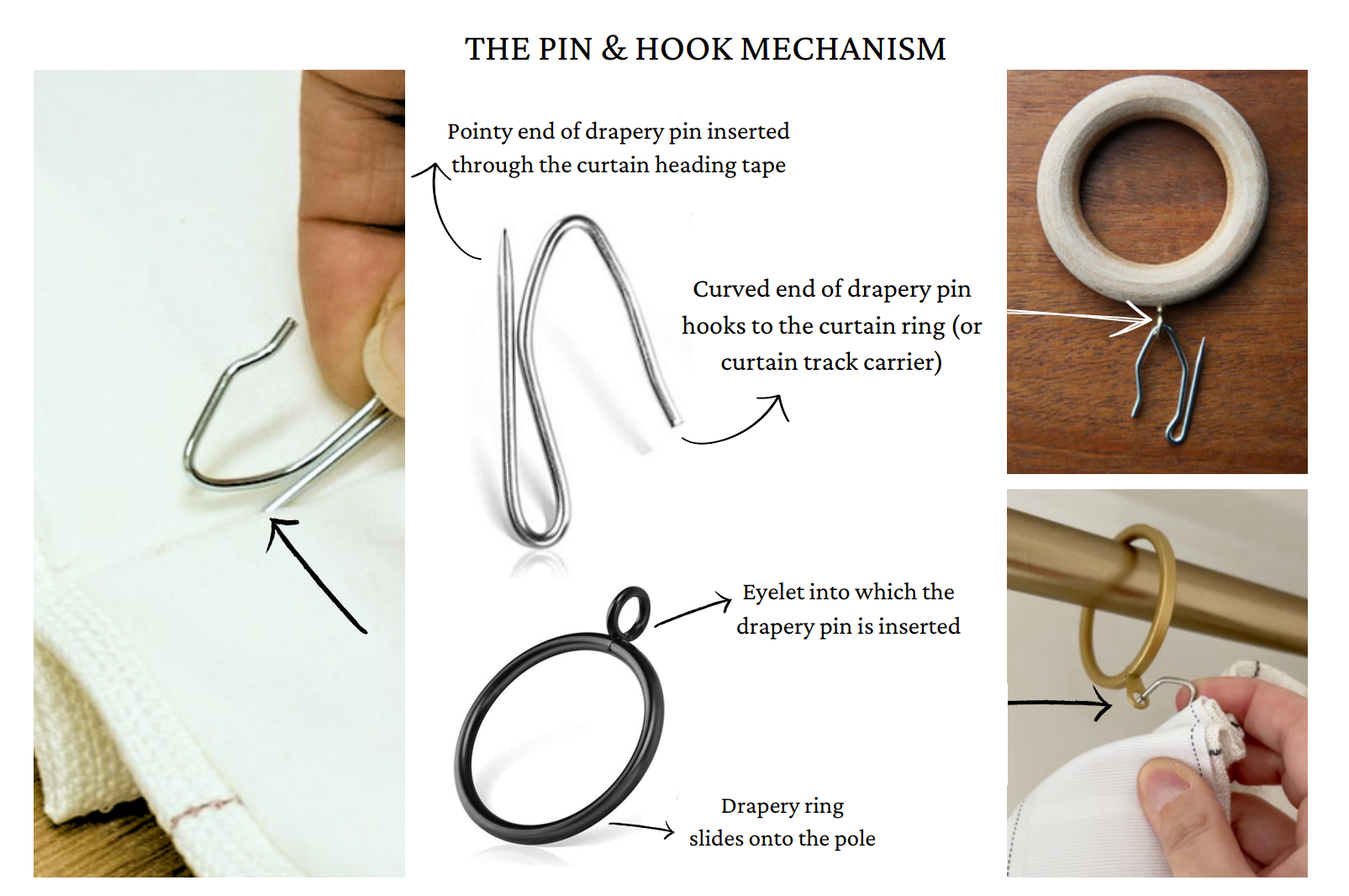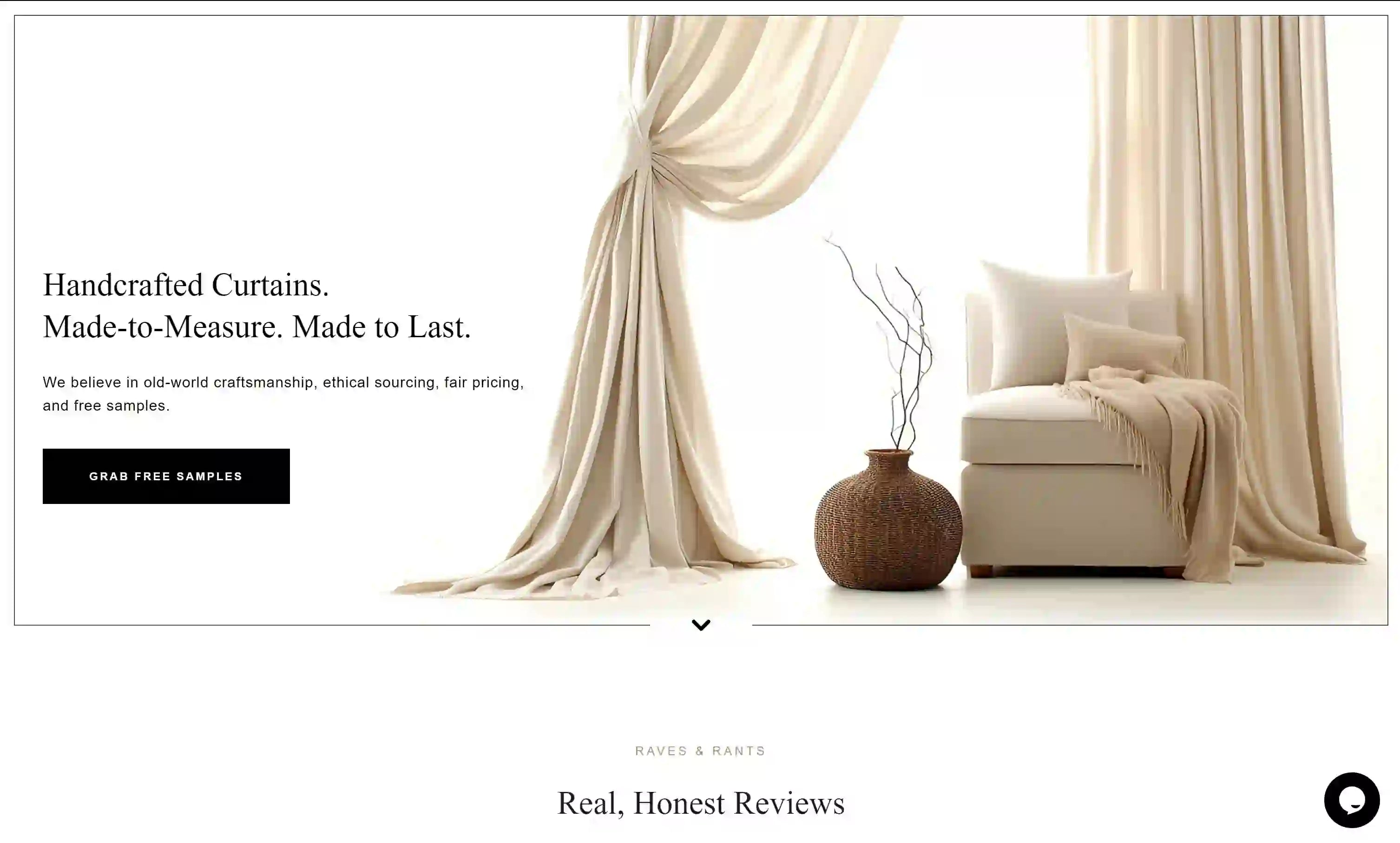Inverted Box Pinch Pleat Curtains & Window Drapes: A Complete Guide
 Image by Ghislaine Viñas
Image by Ghislaine Viñas
Are you looking for made-to-measure curtains that embody the tailored elegance of pinch pleat drapes but assume a sleek modern look? The inverted box pleat curtains from The White Window will immediately step up to the call.
Departing from the flowery elaborate pleating that characterises the pinch pleat drapery family, inverted box pinch pleat curtains feature flat, boxy folds that maintain a clean-lined look. With the fabric folded backward and inward in each pleat, the header of the curtains features a flat, sleek profile. So, when the curtains cover the window, they don a smooth neat appearance. That makes them a great candidate for minimal chic spaces and masculine decor styles that heavily lean on straight-edged beauty and no-fuss aesthetics.
Inverted box pleat drapes are also extremely versatile. You can dress up any space of your home with them - from the formal living room to the casual kids’ room - as they can look homely even with their highly architectural appeal. And, no matter what decor style you follow, you will find inverted box pleat drapes fit to deliver on the mandate.
If you want to dig in for more information on this sleek style for your home, be happily informed that you’re at the one-stop destination where all your curiosity and doubts will be put to rest.
What are Inverted Box Pinch Pleat Drapes?

Known for their decorative yet neat structured look, inverted box pinch pleat drapes feature headers with ‘topstitched box pleats’. As their name suggests, their headers have box pleats on the reverse side. The pleats are thus ‘hidden’ from the front view but the drapes carry rich fullness and tailored beauty.
That’s how inverted box pleat drapes flaunt a sleek, flat header while still carrying the fullness of pinch pleat drapery. Their smooth, clean-lined silhouette is completely in tune with the aesthetics of contemporary homes and masculine decor. And, their sumptuous, full-bodied and architectural appeal makes them fit for formal settings while their understated elegance finds them rhyming with casual aesthetics at the same time.
However, inverted box pleat drapes may not be the ideal choice in certain situations. Owing to the header featuring flat wide folds across the width of the header, box pleat drapes do not ‘compress’ as much when gathered. They need more room to stack. Hence, most clients use this style on decorative, stationary panels that flank the sides of the window without actually covering them. But the style works well for fully functional curtains if you’re not expecting to operate them often or like to leave them covering the windows always, as is the case with sheers.
What are the Reasons to Choose Inverted Box Pinch Pleat Curtains?
 Image by Baxter Creative Limited
Image by Baxter Creative Limited
Inverted box pleat draperies are a distinguished style of drapery that caters to a specific aesthetic taste. They are different from the rest of the pinch pleat family in the sense that their pleats are sleeker in profile and less ornate. And yet, due to the tailored nature of their ‘fixed’ pleats, this style is also different from the casual heading styles whose pleats are formed by hand-gathering the curtain panel on the pole. But, besides the fact that they are unique, there is more to this style of drapery that you may love, such as:
MORE FULLNESS: Inverted box pleat curtains from The White Window are typically stitched with more than 2.5x fullness, that is, two and a half times the width of the window. Our generous use of fabric coupled with uniformly stitched pleats ensures a sumptuous and controlled ‘gather’ of the fabric. This voluminous look of the drapery suits right for formal rooms while the sleek top makes them suitable for casual rooms too.
MODERN CLEAN LINES: The flat folds of the header as opposed to the ‘rising’, flowery folds of the other pinch pleat drapes offer a clean line aesthetic that modern minimalists prefer. Since the pleats are ‘inverted’ - seated on the reverse side of the header - the drapery has a flat-fronted look, and yet also allows for sumptuous fullness. Those who like to have the fullness and waviness that pleats bring to drapes but would rather not ‘see’ the top pinch pleats would prefer inverted box pleat drapes.
MASCULINE FLAVOUR: The boxy pleats of the drapery with their very uncomplicated construct and clean lines bestow a masculine flavour to the drapery. Their straight edges and refined silhouettes contribute to the straightforward aesthetics that usually define masculine design styles. So, if you’re looking for a drapery for a man’s den, a teen boy’s bedroom or a bachelor pad, this is it!
LIGHT CONTROL AND PRIVACY: Unlike curtains that feature fabric loops or grommets, inverted box pleat drapes offer unbroken coverage. So, there are no gaps or eyelets for light to peek through, making them more efficient at providing light control and privacy.
VERSATILITY: Whether your home has tracks or poles, inverted box pinch pleats can go well with both. So, if you’re looking to update your home decor with new curtains, go for inverted box pleat drapes without any worries about having to invest in new hardware.
What are the Factors to Be Considered When Shopping for Inverted Box Pinch Pleat Curtains?

Image by Carter Kay Interiors
With an impressively versatile visual appeal and equally efficient functionality, inverted box pinch pleat curtains stand out as topline candidates for various rooms and styles of decor. If you’re planning to introduce them to your home, these are the factors to keep in mind when styling them.
SUITABILITY OF DRAPERY FABRIC: While all types of drapery fabrics are technically suitable for inverted box pleat drapes, we recommend plain and textured fabrics over all others. The silhouettes of the pleats get a clear visual definition on plain fabrics and the sumptuous tailored beauty of the drapery comes under the spotlight.
But, should you have your heart set on patterns, we recommend choosing the fabric carefully. Patterns get abruptly cropped and partially concealed within the top folds of the pleats, making for a somewhat ‘messy’ header. This lack of visual continuity is especially glaring in stripes, plaids and large-scale motifs. Small-scaled, non-geometric motifs are the safest bet.
STACKING ROOM: Since inverted box pleat drapes have inward-folded pleats and more fullness, their headers are a bit stiff, and hence, they need more room to stack when not in use than most other heading styles. For this reason, we recommend inverted pleats style primarily for stationary drapes or low-width decorative panels that don’t need to be operated often.
You can, however, use them for fully functional drapes by providing more area for stackback. So, extend the drapery pole sufficiently beyond the window so that the drapes can be stacked there neatly, leaving the window free for use. Or, if your windows are over-wide or you have a sweeping curtain wall, you may not be bothered at all as the stackback takes little away from the window’s mega-capacity to provide access to light, air and scenic views.
SUITABILITY WITH DECOR STYLE: While inverted box pleat drapes can deck a wide variety of spaces and sync with various decor styles, it is wise to check whether your taste is served well or not. So, here are some points to consider:
If your home is revelling in traditional ornate details, and you’re looking for curtains for a formally dressed-up room, the flat look of box pleats may look less gratifying; rather you may find goblet pleat drapes or triple pinch pleat drapes that have more prominently decorated headers better suited. But, if you’ll overtreat the drapes with a valance, you may find box pleat drapes to be a more practically efficient alternative because of their sleek headers which allow for easy movement of drapes behind the valance.
In more casual spaces and contemporary homes - especially in masculine decor styles - inverted box pleat drapes are loved for their simple construct and less feminine appeal. They enjoy preference over other styles of drapery in spaces exclusively designed for men because of their refined construct and visual appeal.
PRECISE MEASUREMENTS: Like all pinch pleat drapes, box pleat drapes feature ‘fixed’ headers. The pleats are pre-stitched into the header, and therefore you get a ‘fixed’ level of pole coverage with each panel.
In contrast, styles that don’t have pre-stitched pleats such as grommet tops, rod pockets or tab tops are ‘hand-gathered’ on the pole to form pleats. They can be stretched for more coverage although you’ll then be left with sparser pleats.
Box pleat drapes cannot be stretched beyond the span of their header to offer wider coverage. So, measure your drapery pole correctly and then specify the width of each panel precisely in the order. If the measurement falls short, you will have drapes that leave the window partially uncovered.
SHOP NOW: CUSTOM PLAIN & TEXTURED CURTAINS FROM THE WHITE WINDOW
What are the Hardware Options for Inverted Box Pinch Pleat Curtains?

Inverted box pinch pleat drapes are a very versatile style of drapery that is compatible with both tracks and poles. Accordingly, you may need to invest in appropriate hardware accessories such as drapery pins and eyelet rings for poles and drapery hooks for tracks.
How are Inverted Box Pinch Pleat Curtains Measured?
 Image by Ghislaine Vinas / Garrett Rowland
Image by Ghislaine Vinas / Garrett Rowland
Despite the elaborate form of pleating that inverted box pleat curtains offer, the math behind placing their orders is simple. Here’s how you go about it:
HOW TO MEASURE LENGTH

If you're mounting your inverted box pleat curtains from a decorative pole with rings, and would like the show-worthy hardware to be visible, start measuring length from just below the curtain ring, up to the desired end point.
If mounting from a track, most clients prefer to hide the hardware. In this case, we recommend measuring length from the top of the track to the desired end point.
You may choose your drapery to stop at the window sill, or at a recommended length of 10-15cm below the window sill, or even better, as the stylists tout, go for floor-length or puddled drapes that match the tailored look of the style.
Ultimately, the curtain fall length comes down to the taste of each client. While any pinch pleat is best donned in long lengths, one may choose other endpoints based on the space available, or personal preferences.
HOW TO MEASURE WIDTH

As mentioned earlier, inverted box pinch pleat curtains have ‘fixed pleats’ that are stitched in and cannot be adjusted. Therefore, specifying panel widths accurately is quite important. And depending on the kind of hardware you have in place or plan to purchase, the end widths of your drapery panels may vary slightly.
The three key hardware options are: curtain tracks, standard drapery poles, and French return drapery poles. Let's go over steps to measure drapery panel widths taking into account each of these hardware options.
CURTAIN TRACKS/ STANDARD DRAPERY POLES: Start by measuring the length of your track or pole (finial to finial). Then based on whether you're planning to mount a pair of curtains or one single panel to drape the track/pole, follow the sizing guidance below:
For a single panel of inverted pleat drapery, add 10cm to the measured length of your pole/track to reach the final width of your drapery panel. This extra 10cm is to ensure a safe margin for full coverage of the pole. For a 100cm pole/track, for example, we advise final panel width of 110cm for a single drapery panel.
If ordering a pair of curtains for the same curtain track/pole, add 20cm to the length of pole/track. Then halve this total measurement to reach the final width of each drapery panel. The extra width of 20cm ensures sufficient panel width for curtains to sufficiently overlap when drawn together, thereby preventing any light leaks in the middle.
To explain with an example, if your curtain track/pole measures 100cm, add 20cm to this measure, reaching 120cm. Based on guidance above, the final width of each of your drapery panels should be (100+20) ÷ 2 = 60cm each.
FRENCH RETURN DRAPERY POLES: Also known as wraparound curtain poles, French return drapery poles feature curved or angled ends. Drapery mounted on this style of poles seals the gap between the wall and the pole, thereby eliminating light leaks from the edges.
For French return poles, the panel measurements need to factor in extra width to cover the returns, which typically are 10cm on each side.
Start by measuring the pole end to end, including the returns on both ends. Then, follow the sizing guidance offered above for tracks/standard poles, taking into account whether you're mounting a single panel or a pair to cover your pole.
Bonus Tip: In case you have drapery tracks/poles without returns, but would like to enjoy the clean designer look and light-blocking benefits offered by the French return drapery poles, we highly recommend the hook and eye hack.
While we hope that with the above instructions, you will be able to measure up your required drapery width with ease, in case there’s a hiccup along the tape, be assured you'll find us just an email away to assist you!
How to Hang Inverted Box Pinch Pleat Curtains & Drapes?

Pinch pleat curtains can be hung on both tracks and poles using drapery pins. While we recommend using only show-worthy poles for goblet pleats or French pinch pleats, inverted box pleats can grace both tracks or drapery poles with equal splendour.
So, regardless of the hardware you use, below is our step-by-step guide to hang inverted box pleat curtains:

STEP 1: On the backside of your inverted box pleat curtains, you’ll find a 10cm heading tape sewn at the top. Our tape features three different pin insertion points, offering three ‘levels’ to insert drapery pins. This provides the flexibility of being able to choose the exact height you’d like your drapes to sit. Choose the level that you’d like to use for the best possible height/look for your drapery, while factoring in if you’d like your track/pole to be visible or hidden.
STEP 2: Start inserting drapery pins along the entire length of the tape, aiming for one drapery pin behind every ‘box pinch’, by simply pushing the pointy end of the pin through the tape. Ensure that the pins are inserted securely and evenly spaced across the width of the curtain.
STEP 3: Once all the drapery pins are inserted in the heading tape, hook the curved end of the pin into the eyelet of the drapery ring, clip, or track carrier. Ensure that each pin is firmly secured in the hardware to prevent any slipping or sagging of the curtains. And that’s it!
In Closing

Image by Jillian Harris
Inverted box pleat drapery proffers a highly tailored sumptuous appeal on a sophisticated note. Offering a large bandwidth to adapt to various decor styles and moods, this drapery can bring that touch of refinement that you are looking for in your formal living room as well as the casual ease that pervades a family dining room. If that sounds like your dream drapery, launch into the shopping spree. Our catalogue awaits you with delicious hues, attractive patterns and soothing textures. Find the fabric of your interest and dress your windows with the straight-edged beauty of box pleat drapes!

